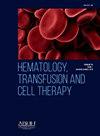一种用于氟-18 标记的硼复合物,以宠物成像应用为目标
IF 1.8
Q3 HEMATOLOGY
引用次数: 0
摘要
引言/理由正电子发射断层扫描(PET)是一种在全球范围内迅速发展的临床模式,这得益于紧凑型医用回旋加速器和生产放射性药物的自动化化学技术的出现。尽管有碳-11[11C]、氟-18[18F]和镓-68[68Ga]等多种正电子发射放射性核素,但 18F 因其 110 分钟的适当半衰期而在研究和诊断核医学中占据了更重要的地位。目前,18F-氟脱氧葡萄糖[18F]FDG 是用于检测各种神经系统疾病和癌症的最常用放射性药物。由于形成碳-氟键的标准 18F 氟化方法存在一些局限性,如产率低和需要苛刻的反应条件,因此包括形成硼-氟-18 键在内的无机方法有可能在室温下产生高比活度,形成在体内稳定的键。该硼复合物计划用于氟-18 标记,目的是开发一种潜在的 PET 放射性药物。这项工作的目的是用三价和四价螯合剂生产一种新的硼化合物,这种硼化合物在空气和溶液中相对稳定,但在氟离子存在时会发生反应,形成一种惰性氟化物种,目的是将其用于氟-18 标记和 PET 成像中。材料与方法 按照之前描述的方法合成了一种四价三价螯合剂,名为 3-((双-(2-羟乙基)氨基)甲基)-2-羟基-5-甲基苯甲醛(缩写为 H3L),并将其与硼酸在乙腈中进行等摩尔定量反应,在回流条件下过夜,制备出一种中性四配位硼络合物,命名为[BL],为白色固体,经过滤、干燥和表征。通过光谱监测,观察到[BL]和 NaF 在甲醇溶液中形成了一种新的物质,应该是 Na[BFL]。结果通过多种技术,包括质谱、傅立叶变换红外光谱、紫外可见光谱、核磁共振光谱(1H、13C 和 11B)和单晶 X 射线衍射,对 H3L 自由配体和硼络合物进行了令人满意的表征。游离配体中的三个羟基被去质子化后形成了[BL]复合物,其氧根与氮原子一起形成了配位层。配位化合物具有扭曲的四面体配位几何形状,这可能有利于硼原子和氟离子(氟离子是一种强亲核体)之间形成键合,削弱了硼-氮键,但保持了氧供体原子与硼中心的强配位。该配合物在氟化物存在下形成了一种新的物种。对 [BL] 单晶的 X 射线衍射证实了它的结构。硼中心与配体 L3- 呈四配位,配体 L3- 通过一个氮原子和三个氧供体原子进行三离子和四配位。所获得的硼配合物在溶液中与氟化物发生反应,形成了一种新的物种,证实了其在[18F]氟化物标记中的潜在应用。本文章由计算机程序翻译,如有差异,请以英文原文为准。
A BORON COMPLEX DESIGNED FOR FLUORINE-18 LABELING AIMING FOR PET IMAGING APPLICATION
Introduction/Justification
Positron emission tomography (PET) is a rapidly expanding clinical modality worldwide due to the availability of compact medical cyclotrons and automated chemistry for the production of radiopharmaceuticals. Despite the availability of various positron-emitting radionuclides such as carbon-11 [11C], fluorine-18 [18F], and gallium-68 [68Ga], 18F has gained more importance and preeminence in research and diagnostic nuclear medicine due to its appropriate half-life of 110 min. Currently, 18F-fluorodeoxyglucose [18F]FDG is the most used radiopharmaceutical for the detection of various neurological disorders and cancer diseases. Since standard 18F-fluorination methods to form carbon-fluorine bonds have some limitations, such as low yield and the requirement for harsh reaction conditions, inorganic approaches, including the formation of boron-fluorine-18 bonds, have the potential to give high specific activities at room temperature, forming a bond that is stable in vivo. The boron complex is planned to be used in fluorine-18 labeling, aiming to develop a potential radiopharmaceutical for PET.
Objectives
This work aims to produce a new boron compound with a trivalent and tetradentate chelating agent, relatively stable in air and in solution, but reactive in the presence of fluoride ions, to form an inert fluorinated species, aiming for its use in fluor-18 labeling and application in PET imaging.
Materials and Methods
A tetradentate trivalent chelator, named 3-((bis-(2-hydroxyethyl)amino)methyl)-2-hydroxy-5-methylbenzaldehyde (abbreviated as H3L), was synthesized as previously described and used to prepare a neutral tetracoordinated boron complex, named [BL], by its equimolar quantitative reaction with boric acid in acetonitrile under reflux conditions overnight, as a white solid, which was filtered, dried, and characterized. By spectroscopic monitoring, the formation of a new species was observed in methanol solution from [BL] and NaF, supposedly forming Na[BFL]. The structures of the [BL] molecule and of the [BFL]1- anion were theoretically calculated by DFT methods.
Results
The H3L free ligand and the boron complex were satisfactorily characterized by diverse techniques, including mass spectrometry, FT-IR, UV-Vis, and NMR spectroscopies (1H, 13C, and 11B) and single crystal X-ray diffraction. The complex [BL] was formed upon deprotonation of three hydroxyl groups in the free ligand, whose oxygens formed the coordination sphere together with the nitrogen atom. The coordination compound has a distorted tetrahedral coordination geometry, which might favor the formation of the bond between the boron atom and the fluoride ion, which is a strong nucleophile, by weakening the boron-nitrogen bond but keeping the oxygen donor atoms strongly coordinated to the boron center.
Conclusion
Both, the free ligand and the boron complex have been successfully synthesized and characterized. The complex forms a new species in the presence of fluoride. X-ray diffraction on a single crystal of [BL] confirms its structure. The boron center is tetracoordinate with the ligand L3-, which coordinates trianionically and tetradentate through one nitrogen and three oxygen donor atoms. The obtained boron complex exhibited reactivity upon fluoride in solution, resulting in the formation of a novel species, confirming its potential application in [18F]fluoride labeling.
求助全文
通过发布文献求助,成功后即可免费获取论文全文。
去求助
来源期刊

Hematology, Transfusion and Cell Therapy
Multiple-
CiteScore
2.40
自引率
4.80%
发文量
1419
审稿时长
30 weeks
 求助内容:
求助内容: 应助结果提醒方式:
应助结果提醒方式:


